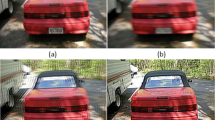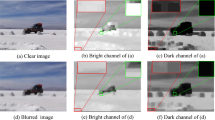Abstract
Image deblurring is an important task for digital cameras. This paper introduces spatial-variant upper and lower bound constraints to regularize Total Variation blind deconvolution. The local upper and lower bound constraints are computed based on the local structure of the observed image. We demonstrate that the proposed spatial-variant constraints can be useful in PSF estimation and image blind deconvolution. Secondly, as other traditional deblurring techniques, the TV blind deconvolution can also produce ringing artifacts. This paper study the GMM-based method to learn the ringing patch distributions. The learned distribution function is then incorporated into the deblurring objective function to suppress the ringing artifacts. Experiments demonstrated the efficacy of the proposed method.














Similar content being viewed by others
References
Almeida MS, Almeida LB (2010) Blind and semi-blind deblurring of natural images. IEEE Trans Image Process 19:36–52
Babacan SD, Molina R, Katsaggelos AK (2009) Variational Bayesian blind deconvolution using a total variation prior. IEEE Trans Image Process 18:12–26
Beck A, Teboulle M (2009) Fast gradient-based algorithms for constrained total variation image denoising and deblurring problems. IEEE Trans Image Process 18:2419–2434
Bertsekas DP (1999) Nonlinear programming. Athena scientific Belmont
Cai J-F, Ji H, Liu C, Shen Z (2009) High-quality curvelet-based motion deblurring from an image pair. IEEE Conference on Computer Vision and Pattern Recognition, pp 1566–1573
Chan TF, Wong C-K (1998) Total variation blind deconvolution. IEEE Trans Image Process 7:370–375
Chan TF, Yip AM, Park FE (2005) Simultaneous total variation image inpainting and blind deconvolution. Int J Imaging Syst Technol 15:92–102
Chartrand R, Wohlberg B (2010) Total-variation regularization with bound constraints. IEEE International Conference on Acoustics Speech and Signal Processing (ICASSP), pp 766–769
Chen X, He X, Yang J, Wu Q (2011) An effective document image deblurring algorithm. IEEE Conference on Computer Vision and Pattern Recognition (CVPR), pp 369–376
Chen X, Yang J, Wu Q (2010) Image deblur in gradient domain. Opt Eng 49:117003
Chen J, Yuan L, Tang C-K, Quan L (2008) Robust dual motion deblurring. IEEE Conference on Computer Vision and Pattern Recognition, pp 1–8
Cho S, Lee S (2009) Fast motion deblurring. ACM Trans Graph (TOG) 145
Cho H, Wang J, Lee S (2012) Text image deblurring using text-specific properties. Computer Vision-ECCV 2012. Springer, pp 524–537
Fergus R, Singh B, Hertzmann A, Roweis ST, Freeman WT (2006) Removing camera shake from a single photograph. ACM Trans Graph (TOG) 25:787–794
Gonzalez RC (2009) Digital image processing. Pearson Education India
Harmeling S, Hirsch M, Sra S, Scholkopf B (2009) Online blind deconvolution for astronomical imaging. IEEE International Conference on Computational Photography (ICCP), pp 1–7
He L, Marquina A, Osher SJ (2005) Blind deconvolution using TV regularization and Bregman iteration. Int J Imaging Syst Technol 15:74–83
Hirsch M, Sra S, Schölkopf B, Harmeling S (2010) Efficient filter flow for space-variant multiframe blind deconvolution. CVPR2010, pp 607–614
Jia J (2007) Single image motion deblurring using transparency. IEEE Conference on Computer Vision and Pattern Recognition, pp 1–8
Joshi N, Kang SB, Zitnick CL, Szeliski R (2010) Image deblurring using inertial measurement sensors. ACM Trans Graph (TOG) 30
Krishnan D, Fergus R (2009) Fast image deconvolution using hyper-Laplacian priors. Advances in Neural Information Processing Systems, pp 1033–1041
Krishnan D, Fergus R (2009) Dark flash photography. ACM Transactions on Graphics, SIGGRAPH
Krishnan D, Tay T, Fergus R (2011) Blind deconvolution using a normalized sparsity measure. IEEE Conference on Computer Vision and Pattern Recognition (CVPR), pp 233–240
Lee DD, Seung HS (1999) Learning the parts of objects by non-negative matrix factorization. Nature 401:788–791
Lee DD, Seung HS (2001) Algorithms for non-negative matrix factorization. Advances in neural information processing systems, pp 556–562
Levin A, Fergus R, Durand F, Freeman WT (2007) Image and depth from a conventional camera with a coded aperture. ACM Trans Graph (TOG) 70
Levin A, Weiss Y, Durand F, Freeman WT (2009) Understanding and evaluating blind deconvolution algorithms. IEEE Conference on Computer Vision and Pattern Recognition, pp 1964–1971
Martin D, Fowlkes C, Tal D, Malik J (2001) A database of human segmented natural images and its application to evaluating segmentation algorithms and measuring ecological statistics. IEEE International Conference on Computer Vision, pp 416–423
Money JH, Kang SH (2008) Total variation minimizing blind deconvolution with shock filter reference. Image Vis Comput 26:302–314
Nayar S, Ben-Ezra M (2004) Motion-based motion deblurring. IEEE Trans Pattern Anal Mach Intell 26:689–698
Rahmani P, Vozel B, Chehdi K (2008) Sequential blind PSF estimation and restoration of aerial multispectral images. Adv Concepts Intell Vis Syst 5259:410–421
Raskar R, Agrawal A, Tumblin J (2006) Coded exposure photography: motion deblurring using fluttered shutter. ACM Trans Graph (TOG) 25:795–804
Rudin LI, Osher S, Fatemi E (1992) Nonlinear total variation based noise removal algorithms. Physica D Nonlinear Phenom 60:259–268
Schuler CJ, Burger HC, Harmeling S, Scholkopf B (2013) A machine learning approach for non-blind image deconvolution. IEEE Conference on Computer Vision and Pattern Recognition (CVPR), pp 1067–1074
Shan Q, Jia J, Agarwala A (2008) High-quality motion deblurring from a single image. ACM Trans Graph (TOG) 73:1–73:10
Tai Y-W, Chen X, Kim S et al (2013) Nonlinear camera response functions and image deblurring: theoretical analysis and practice. IEEE Trans Pattern Anal Mach Intell 35:2498–2512
Tai Y-W, Du H, Brown MS, Lin S (2010) Correction of spatially varying image and video motion blur using a hybrid camera. IEEE Trans Pattern Anal Mach Intell 32:1012–1028
Vogel CR, Oman ME (1996) Iterative methods for total variation denoising. SIAM J Sci Comput 17:227–238
Wang Y, Yang J, Yin W, Zhang Y (2008) A new alternating minimization algorithm for total variation image reconstruction. SIAM J Imaging Sci 1:248–272
Whyte O, Sivic J, Zisserman A, Ponce J (2012) Non-uniform deblurring for shaken images. Int J Comput Vis 98:168–186
Xu L, Jia J (2010) Two-phase kernel estimation for robust motion deblurring. Computer Vision-ECCV 2010. Springer, pp 157–170
You Y-L, Kaveh M (1999) Blind image restoration by anisotropic regularization. IEEE Trans Image Process 8:396–407
Yuan L, Sun J, Quan L, Shum H-Y (2007) Image deblurring with blurred/noisy image pairs. ACM Trans Graph (TOG) 26:1
Zhuo S, Guo D, Sim T (2010) Robust flash deblurring. IEEE Conference on Computer Vision and Pattern Recognition (CVPR), pp 2440–2447
Zoran D, Weiss Y (2011) From learning models of natural image patches to whole image restoration. IEEE International Conference on Computer Vision (ICCV), pp 479–486
Author information
Authors and Affiliations
Corresponding author
Rights and permissions
About this article
Cite this article
Long, W., Chen, X. & Yang, J. Adaptive bound-constrained image deblurring with learned ringing suppression. Multimed Tools Appl 75, 11327–11346 (2016). https://doi.org/10.1007/s11042-015-2856-2
Received:
Revised:
Accepted:
Published:
Issue Date:
DOI: https://doi.org/10.1007/s11042-015-2856-2




